Sex-Based Differences in Lifestyle Behaviours, Self-Esteem, and Academic Performance: A Structural Equation Model in High-Socioeconomic-Status School-Aged Youth from Southern Spain
Highlights
- Sleep time (SLT) was positively associated with Mediterranean diet (MD) adherence and negatively associated with body mass index (BMI). Both physical activity engagement (PA) and MD adherence were positively related to self-esteem (SE), while MD adherence and SE were positively associated with academic performance (AP). These associations remained consistent regardless of socioeconomic status (SES) groups.
- Screen time (ST) emerged as a particularly influential factor among girls, showing negative associations with both PA and MD adherence. These patterns were not observed in boys.
- While a positive association between PA and SE was evident in both sexes, this relationship was stronger in boys.
- In the girls’ model, both MD adherence and SE were positively associated with AP, although this association was not found among boys.
- Interventions should go beyond merely promoting healthy behaviours and include psychological factors such as SE.
- Sex-specific tailoring of interventions is essential to address the distinct needs and patterns observed in boys and girls.
- Early intervention is critical to prevent age-related declines in PA and AP.
Abstract
1. Introduction
- Develop an explanatory model of the relationships between ST, SLT, PA, MD adherence, BMI, SE, and AP in school-aged youth.
- Analyse the associations among the variables included in the model according to sex.
1.1. Current Study
1.2. Theoretical Framework
2. Materials and Methods
2.1. Design and Participants
2.2. Instruments
2.2.1. Physical Activity
2.2.2. Mediterranean Diet Adherence
2.2.3. Self-Esteem
2.2.4. Academic Performance
2.2.5. Ad hoc Questionnaire
2.3. Procedure
2.4. Data Analysis
3. Results
4. Discussion
4.1. Modelling Lifestyle and Academic Outcomes in School-Aged Youth
4.2. Model Associations as a Function of Sex
4.3. Practical Implications and Future Study Perspectives
4.4. Study Limitations and Future Suggestions
5. Conclusions
Author Contributions
Funding
Institutional Review Board Statement
Informed Consent Statement
Data Availability Statement
Acknowledgments
Conflicts of Interest
Abbreviations
| ST | Screen Time |
| SLT | Sleep Time |
| PA | Physical Activity Engagement |
| MD | Mediterranean diet |
| BMI | Body Mass Index |
| SE | Self-Esteem |
| AP | Academic Performance |
| SES | Socioeconomic Status |
References
- Wilhite, K.; Booker, B.; Huang, B.-H.; Antczak, D.; Corbett, L.; Parker, P.; Noetel, M.; Rissel, C.; Lonsdale, C.; del Pozo Cruz, B.; et al. Combinations of physical activity, sedentary behavior, and sleep duration and their associations with physical, psychological, and educational outcomes in children and adolescents: A systematic review. Am. J. Epidemiol. 2023, 192, 665–679. [Google Scholar] [CrossRef]
- Cano-Cañada, E.; Tapia-Serrano, M.Á.; Llanos-Muñoz, R.; Rubio-Morales, A.; Lobo-Triviño, D.; Sánchez-Oliva, D. Influencia de los estilos de vida saludables en el compromiso hacia los estudios y el rendimiento académico en los adolescentes. Rev. Esp. Educ. Física Deport. 2024, 438, 1–12. [Google Scholar] [CrossRef]
- Villodres, G.C.; Salvador-Pérez, F.; Chacón-Cuberos, R.; Muros, J.J. Lifestyle behaviours, self-esteem and academic performance in primary education students—A structural equation model according to sex and school type. Children 2023, 10, 1769. [Google Scholar] [CrossRef]
- Erickson, K.I.; Voss, M.W.; Prakash, R.S.; Basak, C.; Szabo, A.; Chaddock, L.; Kim, J.S.; Heo, S.; Alves, H.; White, S.M.; et al. Exercise training increases size of hippocampus and improves memory. Proc. Natl. Acad. Sci. USA 2011, 108, 3017–3022. [Google Scholar] [CrossRef]
- López-Gil, J.F.; Victoria-Montesinos, D.; García-Hermoso, A. Is higher adherence to the mediterranean diet associated with greater academic performance in children and adolescents? A systematic review and meta-analysis. Clin. Nutr. Edinb. Scotl. 2024, 43, 1702–1709. [Google Scholar] [CrossRef]
- Alvarez-Bueno, C.; Pesce, C.; Cavero-Redondo, I.; Sanchez-Lopez, M.; Martínez-Hortelano, J.A.; Martinez-Vizcaino, V. The effect of physical activity interventions on children’s cognition and metacognition: A systematic review and meta-analysis. J. Am. Acad. Child Adolesc. Psychiatry 2017, 56, 729–738. [Google Scholar] [CrossRef]
- Recomendaciones. In Directrices de la OMS Sobre Actividad Física y Comportamientos Sedentarios; World Health Organization: Geneva, Switzerland, 2021. Available online: https://www.ncbi.nlm.nih.gov/books/NBK581973/ (accessed on 30 July 2025).
- Chaput, J.P.; Willumsen, J.; Bull, F.; Chou, R.; Ekelund, U.; Firth, J.; Jago, R.; Ortega, F.B.; Katzmarzyk, P.T. WHO guidelines on physical activity and sedentary behaviour for children and adolescents aged 5–17 years: Summary of the evidence. Int. J. Behav. Nutr. Phys. Act. 2020, 17, 141. [Google Scholar] [CrossRef] [PubMed]
- Pérez Pérez, D.F.; López Martiínez, G.K.; Aguirre Cruz, J.D.R.; Reyes Garces, G.P. Evaluación del impacto de la implementación de programas de actividad física en el rendimiento académico y la salud mental de los estudiantes de una unidad educativa: Una revisión sistemática. ASCE Mag. 2025, 4, 93–110. [Google Scholar] [CrossRef]
- Laurier, C.; Pascuzzo, K.; Jubinville, V.; Lemieux, A. Physical activity and its benefits on adolescents’ mental health through self-esteem. Front. Child Adolesc. Psychiatry 2024, 3, 1503920. [Google Scholar] [CrossRef] [PubMed]
- Villodres, G.C.; Salvador Pérez, F.; Muros, J.J. Factors associated with Mediterranean diet adherence in a sample of high socio-economic status children from southern Spain. Public Health Nutr. 2024, 27, e35. [Google Scholar] [CrossRef] [PubMed]
- Willett, W.C.; Sacks, F.; Trichopoulou, A.; Drescher, G.; Ferro-Luzzi, A.; Helsing, E.; Trichopoulos, D. Mediterranean diet pyramid: A cultural model for healthy eating. Am. J. Clin. Nutr. 1995, 61, 1402S–1406S. [Google Scholar] [CrossRef]
- Camprodon-Boadas, P.; Gil-Dominguez, A.; De la Serna, E.; Sugranyes, G.; Lázaro, I.; Baeza, I. Mediterranean diet and mental health in children and adolescents: A systematic review. Nutr. Rev. 2025, 83, e343–e355. [Google Scholar] [CrossRef] [PubMed]
- Jiménez Boraita, R.; Gargallo Ibort, E.; Dalmau Torres, J.M.; Arriscado Alsina, D. Lifestyle habits, health indicators and sociodemographic factors associated with health-related quality of life and self-esteem in adolescents. Clin. Child Psychol. Psychiatry 2024, 29, 493–512. [Google Scholar] [CrossRef] [PubMed]
- Gautam, N.; Dessie, G.; Rahman, M.M.; Khanam, R. Socioeconomic status and health behavior in children and adolescents: A systematic literature review. Front. Public Health 2023, 11, 1228632. [Google Scholar] [CrossRef]
- Gasol Foundation. Pasos Study. Available online: https://gasolfoundation.org/es/estudio-pasos/ (accessed on 30 July 2025).
- Romero-Roso, L.; Tapia-Serrano, M.Á.; Vaquero-Solís, M.; Sánchez-Miguel, P.A. ¿Pueden los medios tecnológicos de pantalla infl uir en el tiempo de sueño de estudiantes de Educación Secundaria? Rev. Española Educ. Física Deportes 2021, 432, 67–76. [Google Scholar] [CrossRef]
- da Silva, S.S.; da Silveira, M.A.C.; de Almeida, H.C.R.; do Nascimento, M.C.P.; dos Santos, M.A.M.; Heimer, M.V. Use of digital screens by adolescents and association on sleep quality: A systematic review. Cad. Saúde 2022, 38, e00300721. [Google Scholar] [CrossRef]
- Luna, E.M. Influencia de la tecnología en los patrones de sueño de los adolescentes. Alpha Int. J. 2024, 2, 29–37. [Google Scholar] [CrossRef]
- Cartanyà-Hueso, À.; González-Marrón, A.; Lidón-Moyano, C.; Garcia-Palomo, E.; Martín-Sánchez, J.C.; Martínez-Sánchez, J.M. Association between leisure screen time and junk food intake in a nationwide representative sample of Spanish children (1–14 years): A cross-sectional study. Healthcare 2021, 9, 228. [Google Scholar] [CrossRef]
- Tambalis, K.D.; Panagiotakos, D.B.; Psarra, G.; Sidossis, L.S. Screen time and its effect on dietary habits and lifestyle among schoolchildren. Cent. Eur. J. Public Health 2020, 28, 260–266. [Google Scholar] [CrossRef]
- Wallman-Jones, A.; Eigensatz, M.; Rubeli, B.; Schmidt, M.; Benzing, V. The importance of body perception in the relationship between physical activity and self-esteem in adolescents. Int. J. Sport Exerc. Psychol. 2024, 5, 1–23. [Google Scholar] [CrossRef]
- Delgado-Floody, P.; Caamaño-Navarrete, F.; Jerez-Mayorga, D.; Cofré-Lizama, A. Calidad de vida, autoestima, condición física y estado nutricional en adolescentes y su relación con el rendimiento académico. Arch. Latinoam. Nutr. 2019, 69, 174–181. [Google Scholar] [CrossRef]
- Góngora, V.; Banfi, M.M.; Molinares, N.Q.; Mercado, S.; Mebarak, M.R. Imagen Corporal Positiva en adolescentes colombianos. Psicol. Desde Caribe 2024, 41, 104–126. [Google Scholar]
- Avila, K.Y.L.; Guzmán-Saldaña, R.M.E.; Arrieta-Villarreal, J.L.; Platas-Acevedo, S.R. Autopercepción del índice de masa corporal y satisfacción con la imagen corporal en hombres y mujeres estudiantes de secundaria. Rev. Veritas Difus. Científica 2025, 6, 2383–2412. [Google Scholar] [CrossRef]
- Cid-Sillero, S.; Pascual-Sagastizabal, E.; Martinez-de-Morentin, J.I. Influencia de la autoestima y la atención en el rendimiento académico del alumnado de la ESO y FPB. Rev. Psicodidáct 2020, 25, 59–67. [Google Scholar] [CrossRef]
- La Tasa de Abandono Educativa en España y PISA 2022; Funcas. Available online: https://www.funcas.es/articulos/la-tasa-de-abandono-educativa-en-espana-y-pisa-2022/ (accessed on 6 August 2025).
- Franco-Arévalo, D.; de la Cruz-Sánchez, E.; Feu, S. Evolución de la práctica de actividad física durante la transición de la educación primaria a secundaria obligatoria. Univ. Psychol. 2023, 22, 1–8. [Google Scholar] [CrossRef]
- Sáinz, M.; Solé, J.; Fàbregues, S.; García-Cuesta, S. Secondary School Teachers’ Views of Gender Differences in School Achievement and Study Choices in Spain. SAGE Open 2021, 11, 21582440211047573. [Google Scholar] [CrossRef]
- Deci, E.L.; Eghrari, H.; Patrick, B.C.; Leone, D.R. Facilitating internalization: The self-determination theory perspective. J. Pers. 1994, 62, 119–142. [Google Scholar] [CrossRef]
- Bronfenbrenner, U. The Ecology of Human Development: Experiments by Nature and Design; Harvard University Press: Cambridge, MA, USA, 1979. [Google Scholar]
- Martínez-Gómez, D.; Martínez-de-Haro, V.; Pozo, T.; Welk, G.J.; Villagra, A.; Calle, M.E.; Marcos, A.; Veiga, O.L. Fiabilidad y validez del cuestionario de actividad física PAQ-A en adolescentes españoles. Rev. Esp. Salud Pública 2009, 83, 427–439. [Google Scholar] [CrossRef]
- Altavilla, C.; Comeche, J.M.; Comino, I.C.; Pérez, P.C. El índice de calidad de la dieta mediterránea en la infancia y la adolescencia (KIDMED). Propuesta de actualización para países hispanohablantes: e202006057. Rev. Esp. Salud Pública 2020, 94, 8. [Google Scholar]
- Rosenberg, M. Society and the Adolescent Self-Image; Princeton University Press: Princeton, NJ, USA, 1965. [Google Scholar]
- Atienza, F.L. Análisis de la dimensionalidad de la escala de autoestima de Rosenberg en una muestra de adolescentes valencianos. Rev. Psicol. Univ. Tarracon. 2000, 22, 29–42. [Google Scholar]
- Klapp, A. Does grading affect educational attainment? A longitudinal study. Assess. Educ. Princ. Policy Pract. 2015, 22, 302–323. [Google Scholar] [CrossRef]
- Byrne, B.M. Structural Equation Modeling with AMOS: Basic Concepts, Applications, and Programming, 3rd ed.; Routledge: New York, NY, USA, 2016; 460p. [Google Scholar]
- Brosnan, B.; Haszard, J.J.; Meredith-Jones, K.A.; Wickham, S.R.; Galland, B.C.; Taylor, R.W. Screen Use at Bedtime and Sleep Duration and Quality Among Youths. JAMA Pediatr. 2024, 178, 1147–1154. [Google Scholar] [CrossRef]
- Lukoff, K.; Lyngs, U.; Zade, H.; Liao, J.V.; Choi, J.; Fan, K.; Munson, S.A. How the Design of YouTube Influences User Sense of Agency. In Proceedings of the 2021 CHI Conference on Human Factors in Computing Systems, Yokohama, Japan, 8–13 May 2021; Association for Computing Machinery: New York, NY, USA, 2021; pp. 1–17. [Google Scholar]
- Schaffner, B.; Stefanescu, A.; Campili, O.; Chetty, M. Don’t Let Netflix Drive the Bus: User’s Sense of Agency Over Time and Content Choice on Netflix. Proc. ACM Hum.-Comput. Interact. 2023, 7, 128. [Google Scholar] [CrossRef]
- Ben-Joseph, E.P. Trastorno de Retraso de la Fase de Sueño-Vigilia en los Adolescentes (para Padres). Available online: https://kidshealth.org/es/parents/delayed-sleep-teens.html (accessed on 5 August 2025).
- Bibiloni, M.D.M.; Gallardo-Alfaro, L.; Gómez, S.F.; Wärnberg, J.; Osés-Recalde, M.; González-Gross, M.; Gusi, N.; Aznar, S.; Marín-Cascales, E.; González-Valeiro, M.A.; et al. Determinants of Adherence to the Mediterranean Diet in Spanish Children and Adolescents: The PASOS Study. Nutrients 2022, 14, 738. [Google Scholar] [CrossRef] [PubMed]
- Sánchez-Rodríguez, L.; Fernández-Escobar, C.; Ordaz-Castillo, E.; Royo-Bordonada, M.Á. Adherence to mediterranean diet and its associated factors in adolescents from Madrid. Rev. Esp. Salud Publica 2022, 96, e202210076. [Google Scholar]
- Deng, X.; He, M.; He, D.; Zhu, Y.; Zhang, Z.; Niu, W. Sleep duration and obesity in children and adolescents: Evidence from an updated and dose–response meta-analysis. Sleep. Med. 2021, 78, 169–181. [Google Scholar] [CrossRef] [PubMed]
- Córdova, F.V.; Barja, S.; Brockmann, P.E. Consequences of short sleep duration on the dietary intake in children: A systematic review and metanalysis. Sleep. Med. Rev. 2018, 42, 68–84. [Google Scholar] [CrossRef]
- Rivas García, F.; Martos López, A. Estudio de la adherencia a la dieta mediterránea por parte de la población escolarizada de Guadix. J. Negat. No Posit. Results 2018, 3, 392–397. [Google Scholar]
- Moreno, A.G.; Jurado, M.D.M.M. Estilo de vida saludable en la adolescencia: Relación con autoestima y diferencias según sexo. Acción Psicológica 2023, 20, 47–56. [Google Scholar] [CrossRef]
- Fernández-Bustos, J.G.; Infantes-Paniagua, Á.; Cuevas, R.; Contreras, O.R. Effect of Physical Activity on Self-Concept: Theoretical Model on the Mediation of Body Image and Physical Self-Concept in Adolescents. Front. Psychol. 2019, 10, 1537. [Google Scholar] [CrossRef]
- García, S.M.; Garcia-Massó, X.; Torres, G.M. Relationship between physical activity, physical self-perception, healthy lifestyle habits and socioeconomic level in adolescent students. Retos 2023, 49, 1027–1037. [Google Scholar] [CrossRef]
- Singh, B.; Bennett, H.; Miatke, A.; Dumuid, D.; Curtis, R.; Ferguson, T.; Brinsley, J.; Szeto, K.; Petersen, J.M.; Gough, C.; et al. Effectiveness of exercise for improving cognition, memory and executive function: A systematic umbrella review and meta-meta-analysis. Br. J. Sports Med. 2025, 59, 866–876. [Google Scholar] [CrossRef]
- Ciria, L.F.; Román-Caballero, R.; Vadillo, M.A.; Holgado, D.; Luque-Casado, A.; Perakakis, P.; Sanabria, D. An umbrella review of randomized control trials on the effects of physical exercise on cognition. Nat. Hum. Behav. 2023, 7, 928–941. [Google Scholar] [CrossRef]
- García-Pérez-de-Sevilla, G.; Zapata-Lamana, R. Adherence to the Mediterranean Diet and Its Association with Cognitive Function in Children and Adolescents: A Systematic Review of Observational Studies. Children 2025, 12, 789. [Google Scholar] [CrossRef]
- Gómez-Pinilla, F. Brain foods: The effects of nutrients on brain function. Nat. Rev. Neurosci. 2008, 9, 568–578. [Google Scholar] [CrossRef] [PubMed]
- Burger, K.; Mortimer, J.; Johnson, M.K. Self-esteem and self-efficacy in the status attainment process and the multigenerational transmission of advantage. Soc. Sci. Res. 2020, 86, 102374. [Google Scholar] [CrossRef]
- Liu, A.; Guo, M.; Liao, R.; Wang, X. The relationships between self-esteem, self-efficacy, and test anxiety: A cross-lagged study. Stress Health 2024, 40, e3346. [Google Scholar] [CrossRef]
- Suárez-García, Z.; Álvarez-García, D. Uso de redes sociales en la preadolescencia: Diferencias de género. Psychol. Soc. Educ. 2023, 15, 30–39. [Google Scholar] [CrossRef]
- de Sousa, L.P.; Franzoi, M.A.H.; de Morais, R.D.C.M. Influência das mídias sociais no comportamento alimentar de adolescentes / Influence of social media on the eating behavior of adolescents. Braz. J. Dev. 2022, 8, 43489–43502. [Google Scholar] [CrossRef]
- Alonso-Vargas, J.M.; Ubago-Jiménez, J.L.; Puertas-Molero, P.; González-Valero, G.; Melguizo-Ibáñez, E. Motivación y práctica de actividad física en estudiantes de secundaria. J. Sport Health Res. 2023, 15, 117–128. [Google Scholar] [CrossRef]
- Kantanista, A.; Osiński, W.; Borowiec, J.; Tomczak, M.; Król-Zielińska, M. Body image, BMI, and physical activity in girls and boys aged 14-16 years. Body Image 2015, 15, 40–43. [Google Scholar] [CrossRef]
- Quiñonez, A.Á.A. La autoestima, su relación con el rendimiento académico y la deserción universitaria. Sapienza Int. J. Interdiscip. Stud. 2022, 3, 211–225. [Google Scholar] [CrossRef]
- Grzymisławska, M.; Puch, E.A.; Zawada, A.; Grzymisławski, M. Do nutritional behaviors depend on biological sex and cultural gender? Adv. Clin. Exp. Med. 2020, 29, 165–172. [Google Scholar] [CrossRef]
- Bussey, K.; Bandura, A. Social cognitive theory of gender development and differentiation. Psychol. Rev. 1999, 106, 676–713. [Google Scholar] [CrossRef] [PubMed]
- Eccles, J.S.; Wigfield, A. From expectancy-value theory to situated expectancy-value theory: A developmental, social cognitive, and sociocultural perspective on motivation. Contemp. Educ. Psychol. 2020, 61, 101859. [Google Scholar] [CrossRef]
- Pomerantz, E.M.; Altermatt, E.R.; Saxon, J.L. Making the grade but feeling distressed: Gender differences in academic performance and internal distress. J. Educ. Psychol. 2002, 94, 396–404. [Google Scholar] [CrossRef]
- Marsh, H.W.; Martin, A.J. Academic self-concept and academic achievement: Relations and causal ordering. Br. J. Educ. Psychol. 2011, 81, 59–77. [Google Scholar] [CrossRef] [PubMed]
- Hyde, J.S. Gender similarities and differences. Annu. Rev. Psychol. 2014, 65, 373–398. [Google Scholar] [CrossRef]
- Williams, W.M.; Ayres, C.G. Can active video games improve physical activity in adolescents? A review of RCT. Int. J. Environ. Res. Public Health 2020, 17, 669. [Google Scholar] [CrossRef]
- Guerra, L.; Núñez, M.J.C. Programa de hábitos saludables en adolescentes del grado 8° de la Institución Educativa Antonia Santos en la ciudad de Montería. GADE Rev. Científica 2024, 4, 74–83. [Google Scholar] [CrossRef]
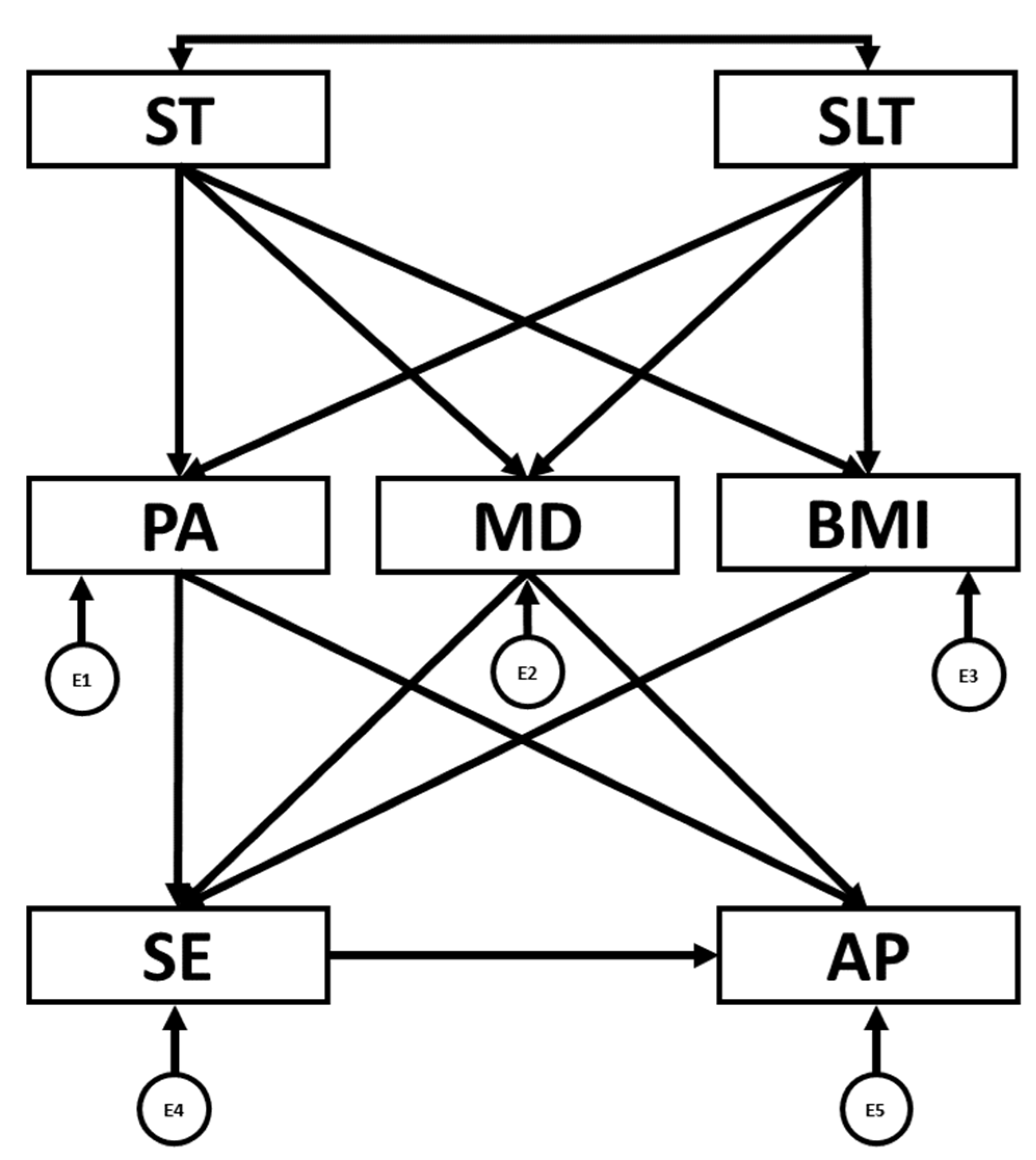
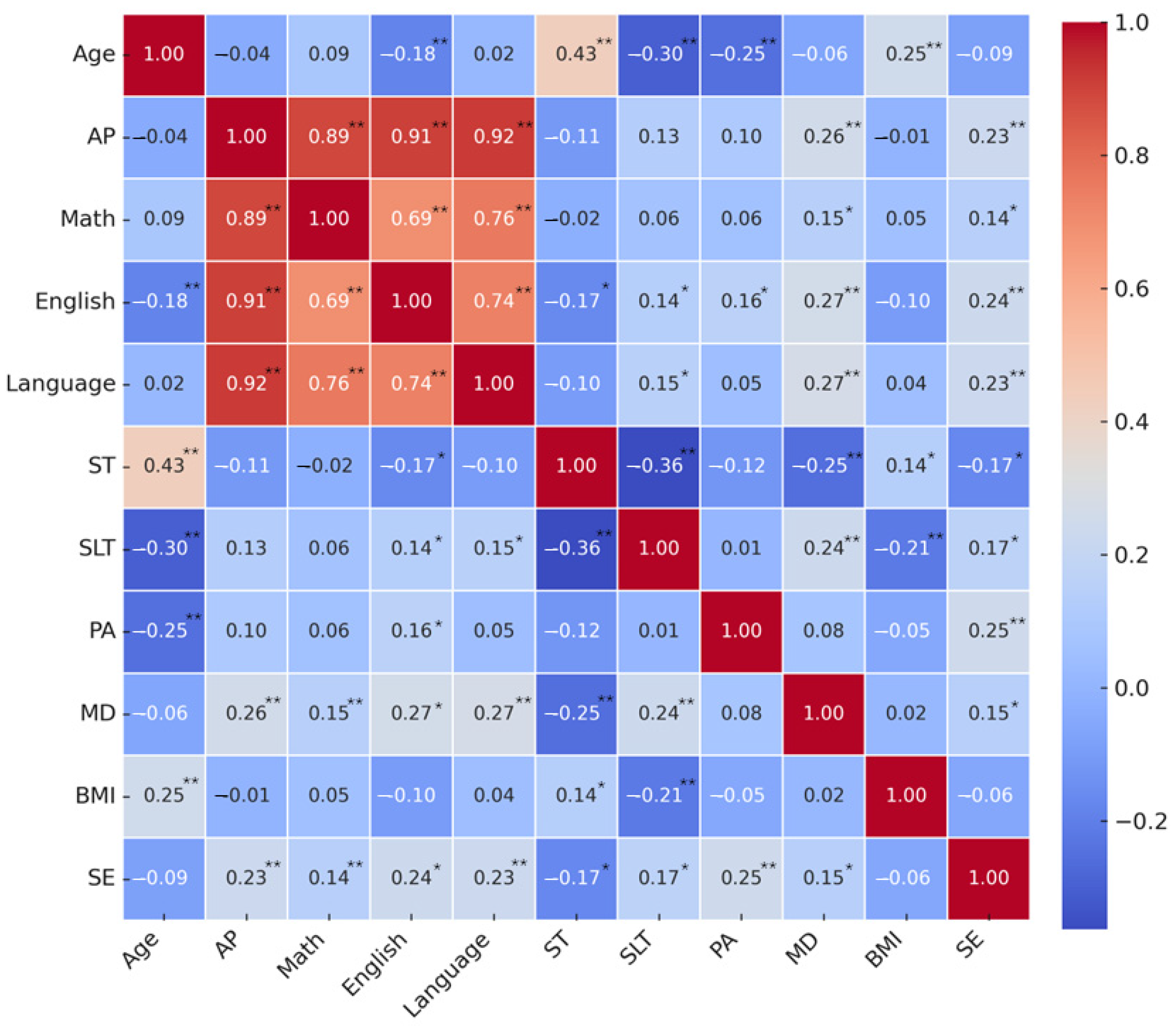
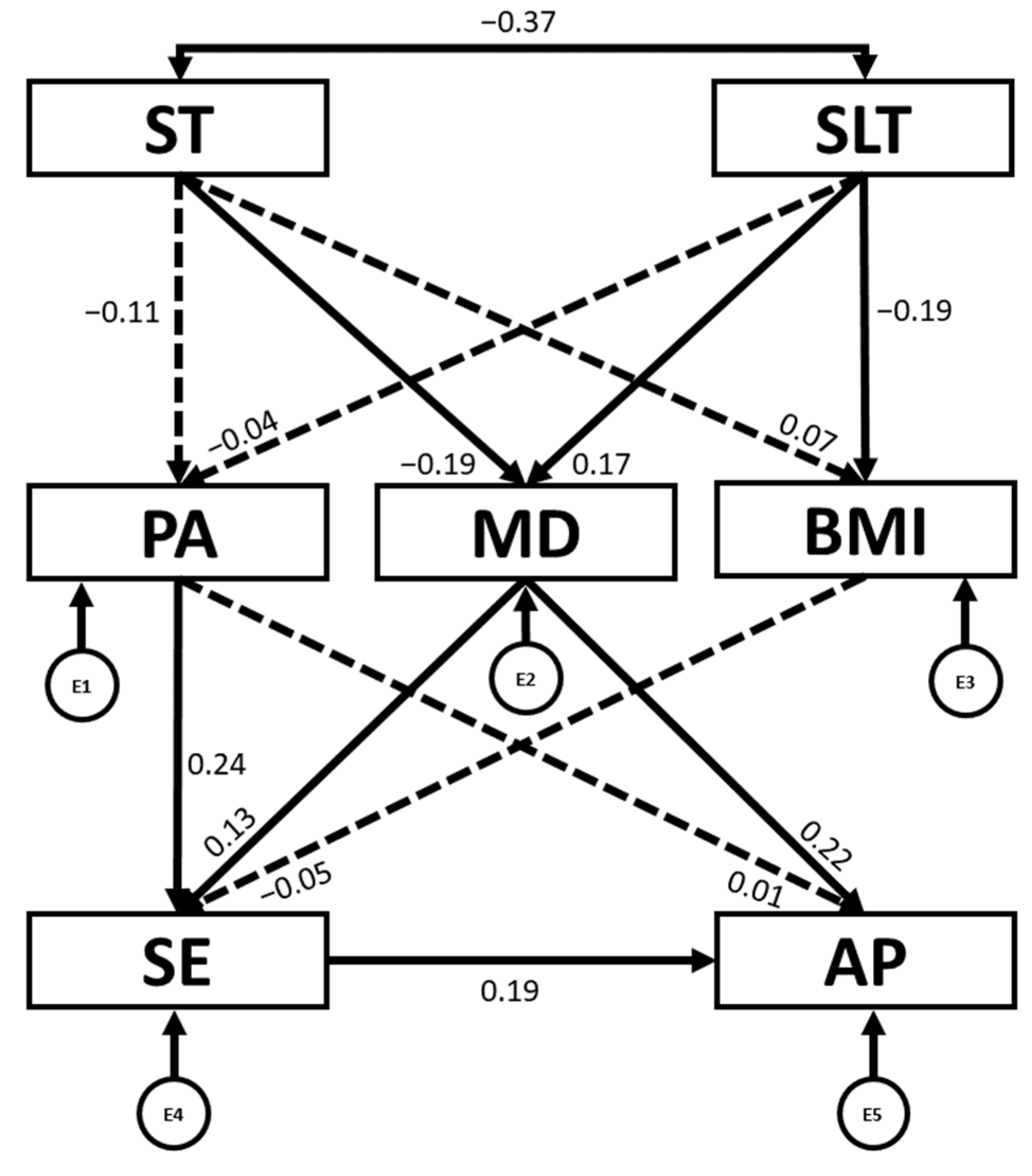
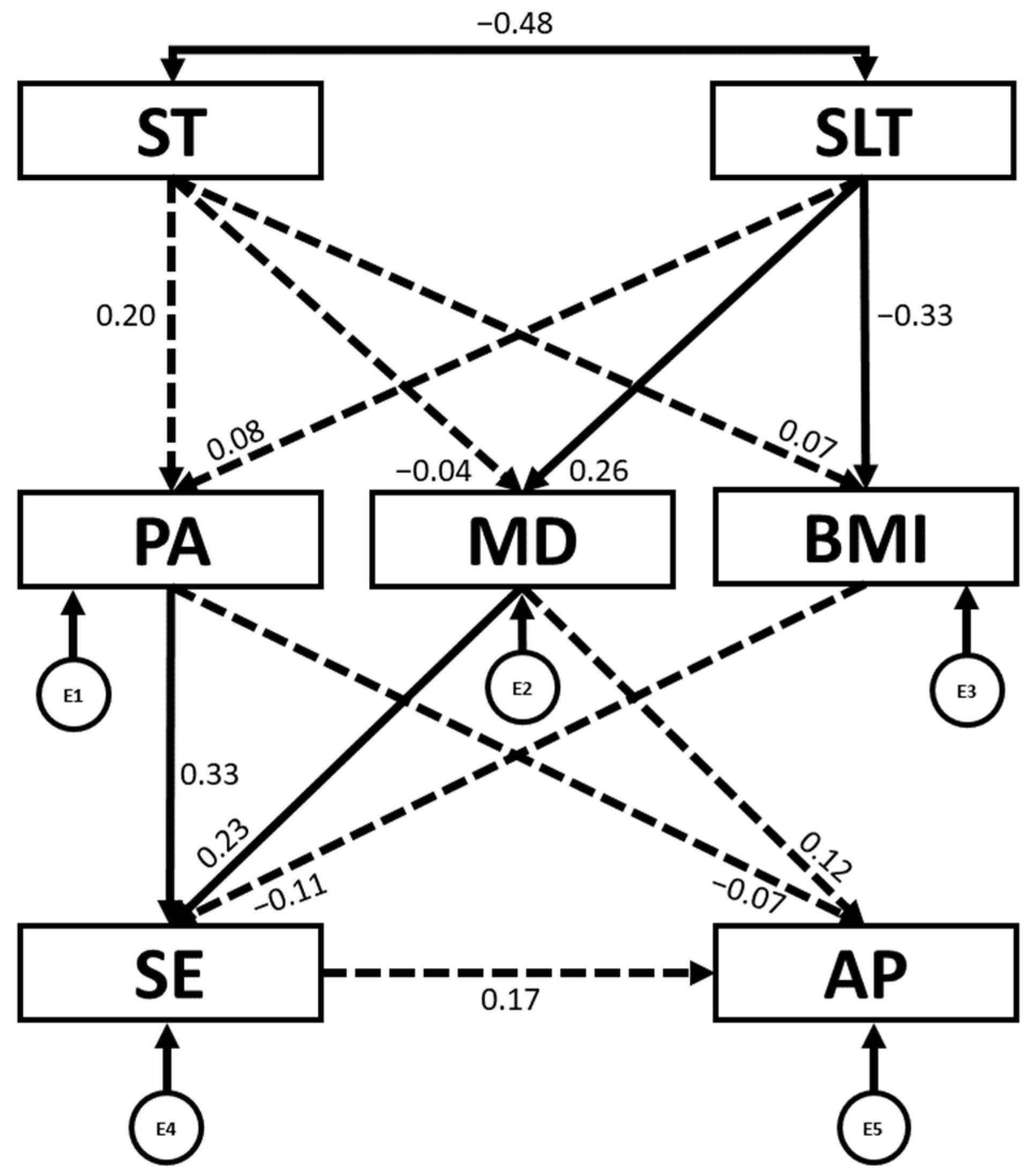
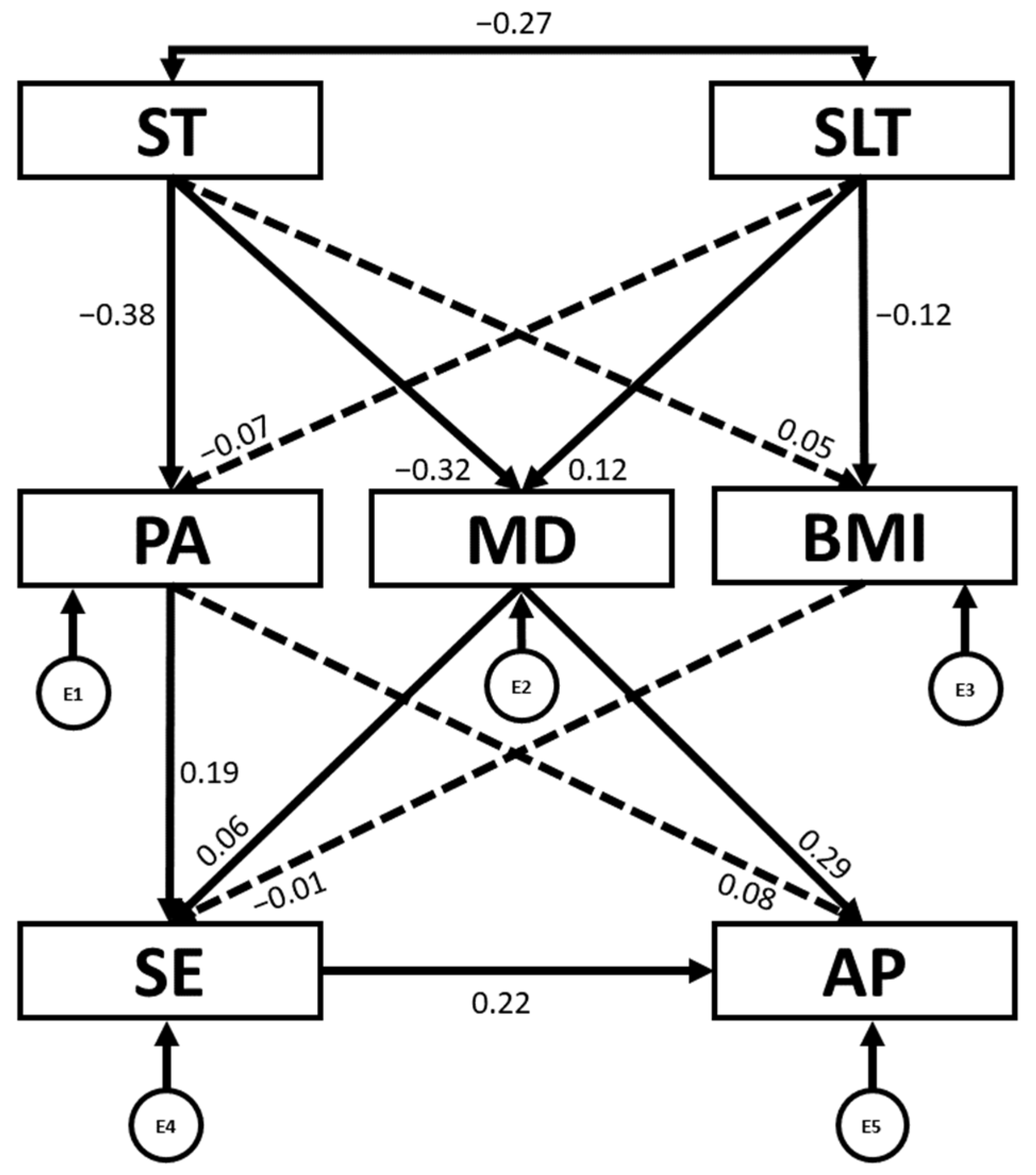
| Sex (n = 217) | p Value | Cohen’s d | Total | ||
|---|---|---|---|---|---|
| Boys (n = 95) | Girls (n = 122) | ||||
| Age | 13.96 ± 1.30 | 13.88 ± 1.32 | 0.470 | 0.061 | 13.88 ± 1.32 |
| AP | 6.60 ± 1.51 | 7.03 ± 1.70 | 0.067 | 0.267 | 6.84 ± 1.63 |
| Math | 6.87 ± 1.46 | 7.01 ± 1.77 | 0.724 | 0.086 | 6.95 ± 1.64 |
| English | 6.60 ± 1.90 | 7.30 ± 2.05 | 0.009 | 0.354 | 6.99 ± 2.01 |
| Language | 6.33 ± 1.68 | 6.80 ± 1.77 | 0.047 | 0.272 | 6.59 ± 1.74 |
| ST | 3.67 ± 2.17 | 3.36 ± 1.73 | 0.509 | 0.158 | 3.50 ± 1.94 |
| SLT | 8.54 ± 0.90 | 8.63 ± 0.99 | 0.723 | 0.095 | 8.59 ± 0.95 |
| PA | 2.87 ± 0.57 | 2.50 ± 0.67 | <0.001 | 0.594 | 2.66 ± 0.65 |
| MD | 6.04 ± 2.46 | 5.93 ± 2.25 | 0.766 | 0.047 | 5.98 ± 2.34 |
| BMI | 19.37 ± 3.04 | 19.62 ± 3.67 | 0.746 | 0.074 | 19.51 ± 3.40 |
| SE | 28.36 ± 3.68 | 27.98 ± 3.94 | 0.452 | 0.100 | 28.14 ± 3.82 |
| Association Between Variables | RW | SRW | |||||
|---|---|---|---|---|---|---|---|
| Estimation | SE 2 | CR | p Value | Estimation | |||
| PA | ← | ST | −0.036 | 0.025 | −1.464 | 0.143 | −0.106 |
| PA | ← | SLT | −0.028 | 0.050 | −0.549 | 0.583 | −0.040 |
| MD | ← | ST | −0.228 | 0.084 | −2.701 | 0.007 | −0.189 |
| MD | ← | SLT | 0.408 | 0.172 | 2.369 | 0.018 | 0.166 |
| BMI | ← | ST | 0.125 | 0.125 | 0.998 | 0.319 | 0.071 |
| BMI | ← | SLT | −0.668 | 0.256 | −2.611 | 0.009 | −0.186 |
| SE 1 | ← | PA | 1.381 | 0.381 | 3.624 | <0.001 | 0.237 |
| SE 1 | ← | MD | 0.212 | 0.107 | 1.986 | 0.047 | 0.130 |
| SE 1 | ← | BMI | −0.053 | 0.073 | −0.726 | 0.468 | −0.048 |
| AP | ← | PA | −0.012 | 0.166 | −0.074 | 0.941 | −0.005 |
| AP | ← | MD | 0.155 | 0.045 | 3.401 | <0.001 | 0.222 |
| AP | ← | SE 1 | 0.080 | 0.029 | 2.780 | 0.005 | 0.187 |
| SLT | ↔ | ST | −0.667 | 0.132 | −5.040 | <0.001 | −0.365 |
| Association Between Variables | RW | SRW | |||||
|---|---|---|---|---|---|---|---|
| Estimation | SE 2 | CR | p Value | Estimation | |||
| PA | ← | ST | 0.053 | 0.030 | 1.751 | 0.080 | 0.202 |
| PA | ← | SLT | 0.050 | 0.073 | 0.683 | 0.495 | 0.079 |
| MD | ← | ST | −0.047 | 0.128 | −0.365 | 0.715 | −0.041 |
| MD | ← | SLT | 0.696 | 0.307 | 2.269 | 0.023 | 0.256 |
| BMI | ← | ST | 0.090 | 0.154 | 0.588 | 0.557 | 0.064 |
| BMI | ← | SLT | −1.098 | 0.369 | −2.975 | 0.003 | −0.325 |
| SE 1 | ← | PA | 2.148 | 0.605 | 3.550 | <0.001 | 0.332 |
| SE 1 | ← | MD | 0.353 | 0.141 | 2.501 | 0.012 | 0.235 |
| SE 1 | ← | BMI | −0.135 | 0.114 | −1.187 | 0.235 | −0.111 |
| AP | ← | PA | −0.185 | 0.282 | −0.657 | 0.511 | −0.070 |
| AP | ← | MD | 0.073 | 0.064 | 1.136 | 0.256 | 0.118 |
| AP | ← | SE 1 | 0.067 | 0.045 | 1.498 | 0.134 | 0.165 |
| SLT | ↔ | ST | −0.992 | 0.221 | −4.168 | <0.001 | −0.476 |
| Association Between Variables | RW | SRW | |||||
|---|---|---|---|---|---|---|---|
| Estimation | SE 2 | CR | p Value | Estimation | |||
| PA | ← | ST | −0.147 | 0.034 | −4.304 | <0.001 | −0.378 |
| PA | ← | SLT | −0.051 | 0.060 | −0.849 | 0.396 | −0.075 |
| MD | ← | ST | −0.410 | 0.114 | −3.582 | <0.001 | −0.315 |
| MD | ← | SLT | 0.277 | 0.201 | 1.378 | 0.168 | 0.121 |
| BMI | ← | ST | 0.115 | 0.198 | 0.582 | 0.561 | 0.054 |
| BMI | ← | SLT | −0.430 | 0.348 | −1.234 | 0.217 | −0.115 |
| SE 1 | ← | PA | 1.115 | 0.525 | 2.123 | 0.034 | 0.190 |
| SE 1 | ← | MD | 0.107 | 0.157 | 0.683 | 0.495 | 0.061 |
| SE 1 | ← | BMI | −0.014 | 0.095 | −0.142 | 0.887 | −0.013 |
| AP | ← | PA | 0.199 | 0.215 | 0.928 | 0.354 | 0.079 |
| AP | ← | MD | 0.222 | 0.063 | 3.523 | <0.001 | 0.295 |
| AP | ← | SE 1 | 0.096 | 0.036 | 2.637 | 0.008 | 0.224 |
| SLT | ↔ | ST | −0.458 | 0.159 | −2.878 | 0.004 | −0.271 |
Disclaimer/Publisher’s Note: The statements, opinions and data contained in all publications are solely those of the individual author(s) and contributor(s) and not of MDPI and/or the editor(s). MDPI and/or the editor(s) disclaim responsibility for any injury to people or property resulting from any ideas, methods, instructions or products referred to in the content. |
© 2025 by the authors. Licensee MDPI, Basel, Switzerland. This article is an open access article distributed under the terms and conditions of the Creative Commons Attribution (CC BY) license (https://creativecommons.org/licenses/by/4.0/).
Share and Cite
Villodres, G.C.; Pérez-Díaz, J.-J.; Salas-Montoro, J.-A.; Muros, J.J. Sex-Based Differences in Lifestyle Behaviours, Self-Esteem, and Academic Performance: A Structural Equation Model in High-Socioeconomic-Status School-Aged Youth from Southern Spain. Children 2025, 12, 1459. https://doi.org/10.3390/children12111459
Villodres GC, Pérez-Díaz J-J, Salas-Montoro J-A, Muros JJ. Sex-Based Differences in Lifestyle Behaviours, Self-Esteem, and Academic Performance: A Structural Equation Model in High-Socioeconomic-Status School-Aged Youth from Southern Spain. Children. 2025; 12(11):1459. https://doi.org/10.3390/children12111459
Chicago/Turabian StyleVillodres, Gracia Cristina, Juan-José Pérez-Díaz, José-Antonio Salas-Montoro, and José Joaquín Muros. 2025. "Sex-Based Differences in Lifestyle Behaviours, Self-Esteem, and Academic Performance: A Structural Equation Model in High-Socioeconomic-Status School-Aged Youth from Southern Spain" Children 12, no. 11: 1459. https://doi.org/10.3390/children12111459
APA StyleVillodres, G. C., Pérez-Díaz, J.-J., Salas-Montoro, J.-A., & Muros, J. J. (2025). Sex-Based Differences in Lifestyle Behaviours, Self-Esteem, and Academic Performance: A Structural Equation Model in High-Socioeconomic-Status School-Aged Youth from Southern Spain. Children, 12(11), 1459. https://doi.org/10.3390/children12111459








